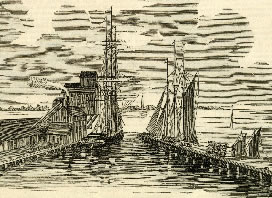
Shipping & receiving materials
Livraison et réception
 Gooderham & Worts’ waterfront location was vital to its long-term growth from a windmill in the wilderness, serving local customers, to the largest distillery in the British Empire, serving customers across the country and around the world.
Gooderham & Worts’ waterfront location was vital to its long-term growth from a windmill in the wilderness, serving local customers, to the largest distillery in the British Empire, serving customers across the country and around the world.
Initially, water transportation was critical. After building its first wharf in 1846, G&W received raw materials like corn (for distilling) and coal (for power), and exported finished products like flour and whisky directly from the distillery wharf.
By 1860, the company had built one of the first grain elevators on Toronto’s waterfront to receive grains more efficiently. At the same time, it embraced the Railway Age that was transforming Canada. When the Stone Distillery opened, it was serviced by both tall ships and railcars. Gradually, railcars came to dominate and eventually the actual shoreline receded to its present location.
Whether transported by ship or railcar, the corn and other grains needed to make alcohol was dumped into hoppers underneath the mill at the east end of the Stone Distillery and started on its journey to becoming alcohol.
 Son emplacement au bord du lac fut vital pour la croissance à long terme de Gooderham & Worts. La compagnie passa de simple moulin à vent construit dans un paysage bucolique et au service d’une clientèle locale à la plus grande distillerie de l’Empire britannique au service d’une clientèle dans tout le pays et partout dans le monde.
Son emplacement au bord du lac fut vital pour la croissance à long terme de Gooderham & Worts. La compagnie passa de simple moulin à vent construit dans un paysage bucolique et au service d’une clientèle locale à la plus grande distillerie de l’Empire britannique au service d’une clientèle dans tout le pays et partout dans le monde.
Au début, le transport se fit surtout par voie maritime. Une fois le premier quai construit en 1846, la compagnie put, directement de son quai à la distillerie, recevoir les matériaux bruts comme le maïs (pour la distillation) et le charbon (pour l’énergie), et exporter ses produits finis comme la farine et le whisky.
La compagnie avait érigé avant 1860 un des premiers silos à grains sur le bord du lac à Toronto pour faciliter ses opérations. Elle entra de plain-pied dans l’épopée ferroviaire qui transformait déjà le Canada. Si bien que lorsque le bâtiment Stone Distillery fut construit, on put y accéder par bateau à voiles et par chemin de fer. Peu à peu, le chemin de fer supplanta les navires, et les rives du lac reculèrent progressivement jusqu’à leur emplacement actuel.
Que le maïs et les autres grains nécessaires à la fabrication d’alcool arrivent par navire ou par chemin de fer, ils étaient déversés dans des cuves sous le moulin, c’est-à-dire dans la partie est du bâtiment Stone Distillery, première étape de leur transformation en alcool.